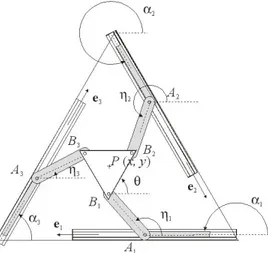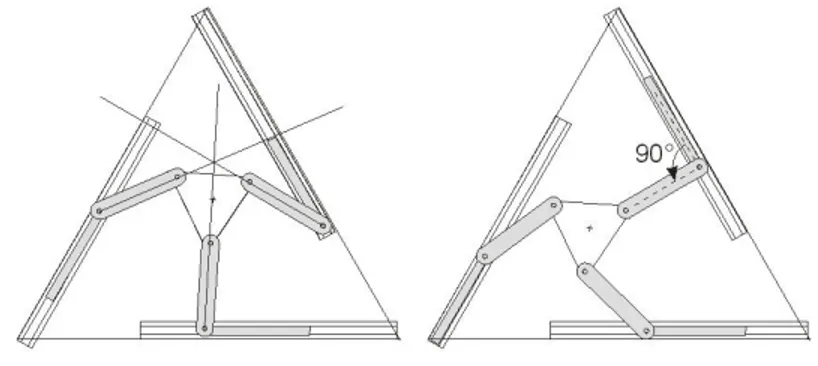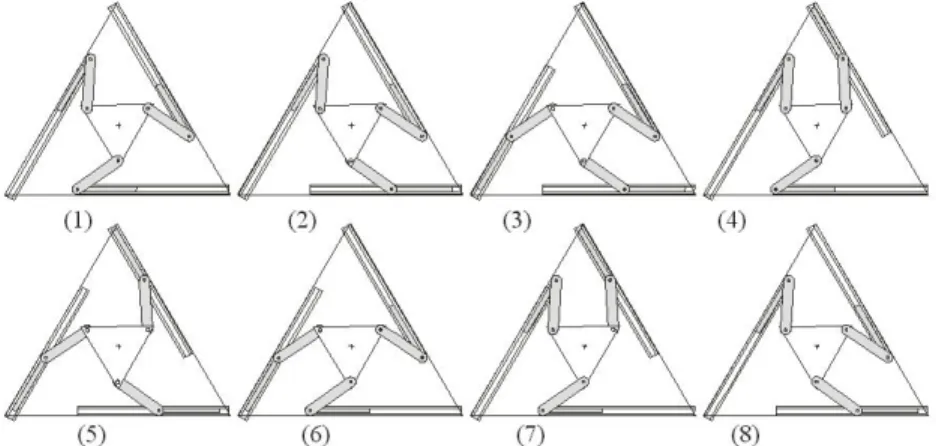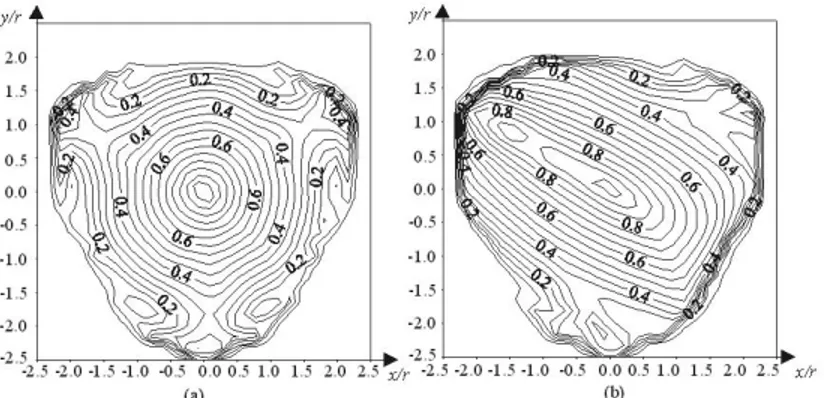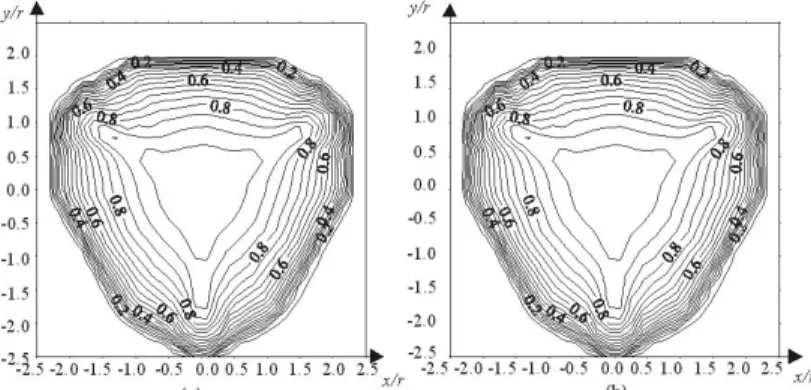HAL Id: hal-00463599
https://hal.archives-ouvertes.fr/hal-00463599
Submitted on 12 Mar 2010
HAL is a multi-disciplinary open access archive for the deposit and dissemination of sci-entific research documents, whether they are pub-lished or not. The documents may come from teaching and research institutions in France or abroad, or from public or private research centers.
L’archive ouverte pluridisciplinaire HAL, est destinée au dépôt et à la diffusion de documents scientifiques de niveau recherche, publiés ou non, émanant des établissements d’enseignement et de recherche français ou étrangers, des laboratoires publics ou privés.
Manipulators
Stéphane Caro, Damien Chablat, Philippe Wenger, Jorge Angeles
To cite this version:
Stéphane Caro, Damien Chablat, Philippe Wenger, Jorge Angeles. The Isoconditioning Loci of Pla-nar Three-Dof Parallel Manipulators. Recent Advances in Integrated Design and Manufacturing in Mechanical Engineering, Kluwer, pp.129-138, 2006, �10.1007/978-94-017-0161-7_13�. �hal-00463599�
1
THE ISOCONDITIONING LOCI OF PLANAR
THREE-DOF PARALLEL MANIPULATORS
Stephane Caro*, Damien Chablat*, Philippe Wenger*, Jorge Angeles**
*
IRCCyN, Ecole Centrale de Nantes, 1 rue de la Noë, 44321 Nantes, France. UMR 6597 CNRS, Ecole Centrale de Nantes, Université de Nantes, Ecole des Mines de Nantes
**
Department of Mechanical Engineering & Center for Intelligent Machines, McGill University, 817 Sherbrooke Street West, Montreal, Canada H3A 2K6
Abstract: This paper deals with a special class of three-degree-of-freedom parallel manipulators. First, the singular configurations of the two Jacobian matrices are studied. The isotropic configurations are then found based on the characteristic length of this manipulator. The isoconditioning loci for the Jacobian matrices are plotted to define a global performance index allowing the comparison of the different working modes. The resulting index is compared with the Cartesian workspace surface and the average of the condition number.
Key words: parallel manipulator, optimum design, isoconditioning loci, characteristic length
1.
INTRODUCTION
Various performance indices have been devised to assess the kinetostatic performances of serial and parallel manipulators. As the literature on performance indices is extremely rich to fit in the limits of this paper, the interested reader is invited to look at it in the rather recent references cited here. A dimensionless quality index was recently introduced by Lee, Duffy, and Hunt [1] based on the ratio of the Jacobian determinant to its maximum absolute value, as applicable to parallel manipulators. This index does not take into account the location of the operation point of the end-effector, because the Jacobian determinant is independent of this location. The proof
of the foregoing result is available in [2], as pertaining to serial manipulators, its extension to their parallel counterparts being straightforward. The condition number of a given matrix, on the other hand, is known to provide a measure of invertibility of the matrix [3]. It is thus natural that this concept found its way into this context. Indeed, the condition number of the Jacobian matrix was proposed by [4] as a figure of merit to minimize when designing manipulators for maximum accuracy. In fact, the condition number gives, for a square matrix, a measure of the relative roundoff-error amplification of the computed results [3] with respect to the data roundoff error. As is well known, however, the dimensional heterogeneity of the entries of the Jacobian matrix prevents the straightforward application of the condition number as a measure of Jacobian invertibility. The characteristic length was introduced in [5] to cope with the above-mentioned heterogeneity.
In this paper, we use the characteristic length to normalize the Jacobian matrix of a three-degree-of-freedom (dof) planar manipulator and to calculate the isoconditioning loci for all working modes.
Figure -1. A three –DOF parallel manipulator
2.
PRELIMINARIES
A planar three-dof manipulator comprising three parallel PRR chains is shown in Fig. 1. This manipulator has been frequently studied, in particular in [6,7]. The actuated joint variables are the displacements of the three prismatic joints, the Cartesian variables being position vector p of operation point P and orientation of the platform. The trajectories of points Ai define
The Isoconditioning Loci of Planar Three-Dof Parallel Manipulators 3
and B3, whose geometric center is point P, lie at the corners of an equilateral
triangle. We thus have i= +( -1)( 2i 3 ), for i1, 2 , 3. Moreover,
1 2 3
ll l l , with li denoting the length of AiBi and rr1 r2 r3, with ri
denoting the length of BiP, in units of length that need not be specified in the
paper. The layout of the trajectories of points Ai is defined by radius R of the
circle inscribed in the associated triangle.
2.1
Kinematic Relations
Velocity .,p of point P can be obtained in three different forms, depending on which leg is traversed, namely,
= i + i ( i i) + ( i) , i[1, 3]
p a E b a E p b (1)
with matrix E and velocity ai of points Ai defined as
where ei is a unit vector in the direction of the ith prismatic joint. We would
like to eliminate the three idle joint rates 1, 2 and 3 from eq.(1), which we do upon dot-multiplying the former by (bi ai)T , thus obtaining
(bi ai)Tp= (bi ai)Tai+ (bi ai)TE p( bi) , i[1, 3] (2) Equation (2) can now be cast in vector form, namely,
1 2 3
w ith and T T A t B ρ t p ρ (3)withρthus being the vector of actuated joint rates. Moreover, A and B are, respectively, the direct-kinematics and the inverse-kinematics matrices of the manipulator, defined as 1 1 1 1 1 2 2 2 2 2 3 3 3 3 3 ( ) ( ) ( ) ( ) ( ) ( ) ( ) ( ) ( ) T T T T T T b a b a E p b A b a b a E p b b a b a E p b (4a) 1 1 1 2 2 2 2 2 2 ( ) 0 0 0 ( ) 0 0 0 ( ) T T T b a e B b a e b a e (4b)
When A and B are nonsingular, we obtain the relations
1 1
w ith and ,
t Jρ J A B ρ K t K B A
2.2
Parallel Singularities
Parallel singularities occur when the determinant of matrix A vanishes [8,9]. At these configurations, it is possible to move locally operation point P with the actuators locked, the structure thus resulting cannot resist arbitrary forces, and control is lost. To avoid any performance loss, it is necessary to have a Cartesian workspace free of parallel singularities. For the planar manipulator studied, such configurations are reached whenever the axes
A1B1, A2B2 and A3B3 intersect (possibly at infinity), as depicted in Fig.2.
Figure -2. Parallel singularity Figure -3. Serial singularity
In the presence of such configurations, moreover, the manipulator cannot resist a force applied at the intersection point. These configurations are located inside the Cartesian workspace and form the boundaries of the joint workspace [8].
2.3
Serial Singularities
Serial singularities occur when det( )Β 0. In the presence of theses singularities, there is a direction along which no Cartesian velocity can be produced. Serial singularities define the boundary of the Cartesian workspace. For the topology under study, the serial singularities occur whenever (bi ai)Tei 0 for at least one value of i, as depicted in Fig.3 for
2
i .
3.
ISOCONDITIONING LOCI
The Isoconditioning Loci of Planar Three-Dof Parallel Manipulators 5
We derive below the loci of equal condition number of the matrices A, B and K. To do this, we first recall the definition of condition number of an
mn matrix M, with m<n, (M). Using Frobenius norm, (M) is the ratio of
the smallest, s, to the largest, l, singular values of M, namely,
( ) s l
M (5)
The singular values of matrix M are defined, in turn, as the square roots of the nonnegative eigenvalues of the positive-definite mm matrix MMT.
3.2
Non-Homogeneous Direct-Kinematics Matrix
To make matrix A homogeneous, as needed to define its condition number, each term in the third column of A is divided by the characteristic length L [10], thereby deriving its normalized counterpart A :
1 1 1 1 1 2 2 2 2 2 3 3 3 3 3 ( ) ( ) ( ) / ( ) ( ) ( ) / ( ) ( ) ( ) / T T T T T T L L L b a b a E p b A b a b a E p b b a b a E p b (6)
which is calculated so as to minimize (A ), along the posture variables 1,
2 and 3. However, notice that B is dimensionally homogeneous, and does
not need to be normalized.
3.3
Isotropic Configuration
In this section, we derive the isotropy condition on J to define the geometric parameters of the manipulator. We shall obtain also the value L of the characteristic length. To simplify A and B, we use the notation
( ) i i i l b a (7a) ( )T ( ) i i i i k b a E pb (7b) ( )T i i i i m b a e (7c) i A B Pi i (7d)
We can thus write matrices A and B as
1 1 1 2 2 2 3 3 3 / 0 0 / 0 0 0 0 / T T T k L m k L m m k L l A l B l (8)
Whenever matrix B is nonsingular, that is, when mi 0, for i1, 2, 3, we obtain
1 1 1 1 2 2 2 2 3 3 3 3 / /( ) / /( ) / /( ) T T T m k L m m k L m m k L m l K l l
Matrix J, the normalized J, is isotropic if and only if K KT 213 3 for
0 and K J1,i.e., 2 2 2 2 (l liT iki /L ) /mi , i[1 , 3] (9a) 2 (l liT jk ki j/L ) /(m mi j)0 , i j, i j, [1, 3] (9b)
From eqs.(9a-b), we can derive the conditions below:
1 2 3 l l l (10a) 1 2 3 p b p b p b (10b) 1 2 2 3 3 1 T T T l l l l l l (10c) 1 2 2 3 3 1 m m m m m m (10d)
In summary, the constraints defined in the eqs.(10a-d) are:
Pivots Bi should be placed at the vertices of an equilateral triangle;
Segments AiBi form an equilateral triangle;
The trajectories of point Ai define an equilateral triangle. Hence,
1 2 3
ll l l .
Notice that the foregoing conditions, except the second one, were assumed in chapter 2.
3.4
The Characteristic Length
The characteristic length is defined at the isotropic configuration. From eq.(9b), we determine the value of the characteristic length as,
1 2 (1 2)
T
L k k l l
By applying the constraints defined in eq.(9a), we can write characteristic length L in terms of angle , i.e.
2 sin ( )
L r
where = 1=2=3, was defined in eq.(7d) and [0 , 2 ] .
This means that the manipulator under study admits several isotropic configurations, two of which are shown in Fig.4a and Fig.4b, whereas the characteristic length L of a manipulator is unique [2]. When is equal to /2, Fig.4a, i.e., when AiBi is perpendicular to BiP, the manipulator finds itself at
a configuration furthest away from parallel singularities. To have an isotropic configuration furthest away from serial singularities, we obtain two conditions: e E bTi ( i ai)0 and rR/ 2.
The Isoconditioning Loci of Planar Three-Dof Parallel Manipulators 7
Figure -4. Two isotropic configurations with two values of
3.5
Working Modes
The manipulator under study has a diagonal inverse-kinematics matrix B, as shown in eq.(4b), the disappearance of one of its diagonal entries thus indicating the occurrence of a serial singularity. The set of manipulator postures free of this kind of singularity is termed a working mode. The different working modes are thus separated by a serial singularity. The formal definition of the working mode is detailed in [8]. For the manipulator at hand, there are eight working modes, as depicted in Fig.5.
Figure -5. The eight working modes of the 3PRR manipulator
However, because of symmetries, we can restrict our study to only two working modes, if there are no joint limits. Indeed, working mode 1 is similar to working mode 5. For the first one, the signs of the diagonal entries of B are all negative. For the second one, they are all positive. A similarly reasoning is applicable to working modes 2-6, 3-7 and 4-8. Likewise, working modes 3-4 and 7-8 can be derived from working modes 2 and 6 by a rotation of 120° and 240°, respectively. Therefore, only working modes 1
and 2 are studied. We label the corresponding matrices as Ai, B, Ki for ith working mode.
3.6
Isoconditioning Loci
For each Jacobian matrix and for all the poses of the end-effector, we calculate the optimum conditioning according to the orientation of the end-effector. We can notice that there is a singular configuration for any orientation of the end-effector.
Fig.6 depicts the isoconditioning loci of matrix A . We depict in Fig.7 the isoconditioning loci of matrix B. We notice that the loci of both working modes are identical. This is due to both the absence of joint limits on the actuated joints and the symmetry of the manipulator. For one configuration, only the signs of mi change from a working mode to another, but the
condition number is computed from the absolute values of mi. The shapes
of the isoconditioning loci of _
,K are similar to those of the isoconditioning loci of A ; only the numerical values vary.
Figure -6. Isoconditioning loci of the matrix (a)A1and (b)A2with R r 2 and l r2
For the first working mode, the condition number of matrix A decreases regularly around the isotropic configuration. The isoconditioning loci resemble concentric circles. However, for the second working mode, the isoconditioning loci of matrix A resemble ellipses. Characteristic length L depends on r. Two indices can be studied according to parameter R:
(i) the area of the Cartesian workspace, called S; (ii) the average of the conditioning, called .
The first index is identical for the two working modes. Fig. 8 depicts the variation of S as a function of R/r, for l r2. Its maximum value is reached
The Isoconditioning Loci of Planar Three-Dof Parallel Manipulators 9
Figure -7. Isoconditioning loci of the matrix (a) B1 and (b) B2 with R r2 and l r2
Figure -8. S = f(R/r) Figure -9. (A1), (A2) = f(R/r)
Figure -10. (B1), (B2) = f(R/r) Figure -11. (K1), (K2) = f(R/r) For the three matrices studied, can be regarded as a global performance index. This index allows us to compare the working modes. Figures.9, 10 and 11 depict (A ), (B) and (K ), respectively, as a function of R/r, with l r2.
The value of (A1) increases with R. At the opposite, the maximum
value of (A2) is reached when R r2. For both the working modes
studied, (B1) and (B2) are identical for R/r fixed. For the first working
mode, the minimum value of (K1) and the maximum area of Cartesian
a compromise under these two indices. For the second working mode, there is an optimum of (K2) close to the optimum of S, for R r2.
4.
CONCLUSIONS
We produced the isoconditioning loci of the Jacobian matrices of a three-PRR parallel manipulator. This concept being general, it can be applied to any three-dof planar parallel manipulator. To solve the problem of heterogeneity of the Jacobian matrix, we used the notion of characteristic length. This length was defined for the isotropic configuration of the manipulator. The isoconditioning curves thus obtained characterize, for every posture of the manipulator, the optimum conditioning for all possible orientations of the end-effector. This index is compared with the area of the Cartesian workspace and the conditioning average. The two optima being different, it is necessary to find another index to determine the optimum values. The results of this paper can be used to choose the working mode which is best suited to the task at hand or as a global performance index when we study the optimum design of these kinds of manipulators.
REFERENCES
[1] Lee J., Duffy J. and Hunt K., A Pratical Quality Index Based on the Octahedral
Manipulator, The International Journal of Robotic Research, Vol. 17, No. 10, October,
1998, 1081-1090.
[2] Angeles J., Fundamentals of Robotic Mechanical Systems, Springer-Verlag, Second Edition, New York, 2002.
[3] Golub G. H. and Van Loan C. F., Matrix Computations, The John Hopkins University Press, Baltimore, 1989.
[4] Salisbury J. K. and Craig J. J., Articulated Hands: Force Control and Kinematic Issues, The International Journal of Robotics Research, 1982, Vol. 1, No. 1, pp. 4-17.
[5] Angeles J. and Lopez-Cajun C. S., Kinematic Isotropy and the Conditioning Index of
Serial Manipulators, The Int. J. of Robotics Research, 1992, Vol. 11, No. 6, pp. 560-571.
[6] Merlet J.P., Parallel robots, Kluwer Academic Publ., Dordrecht, The Netherland., 2000. [7] Gosselin C., Sefrioui J., Richard M. J., Solutions polynomiales au problème de la
cinématique des manipulateurs parallèles plans à trois degré de liberté, Mechanism and
Machine Theory, Vol. 27, pp. 107-119, 1992.
[8] Chablat D. and Wenger P., Working Modes and Aspects in Fully-Parallel Manipulator, Proceedings IEEE Inter. Conference on Robotics and Automation, 1998, pp. 1964-1969. [9] Gosselin C. and Angeles J., Singularity Analysis of Closed-Loop Kinematic Chains, IEEE,
Transaction on Robotics and Automation, Vol. 6, pp. 281-290, June 1990.
[10] Ranjbaran F., Angeles J., Gonzalez-Palacios M.A. and Patel R.V., The Mechanical
Design of a Seven-Axes Manipulator with Kinematic Isotropy, Journal of Intelligent and
